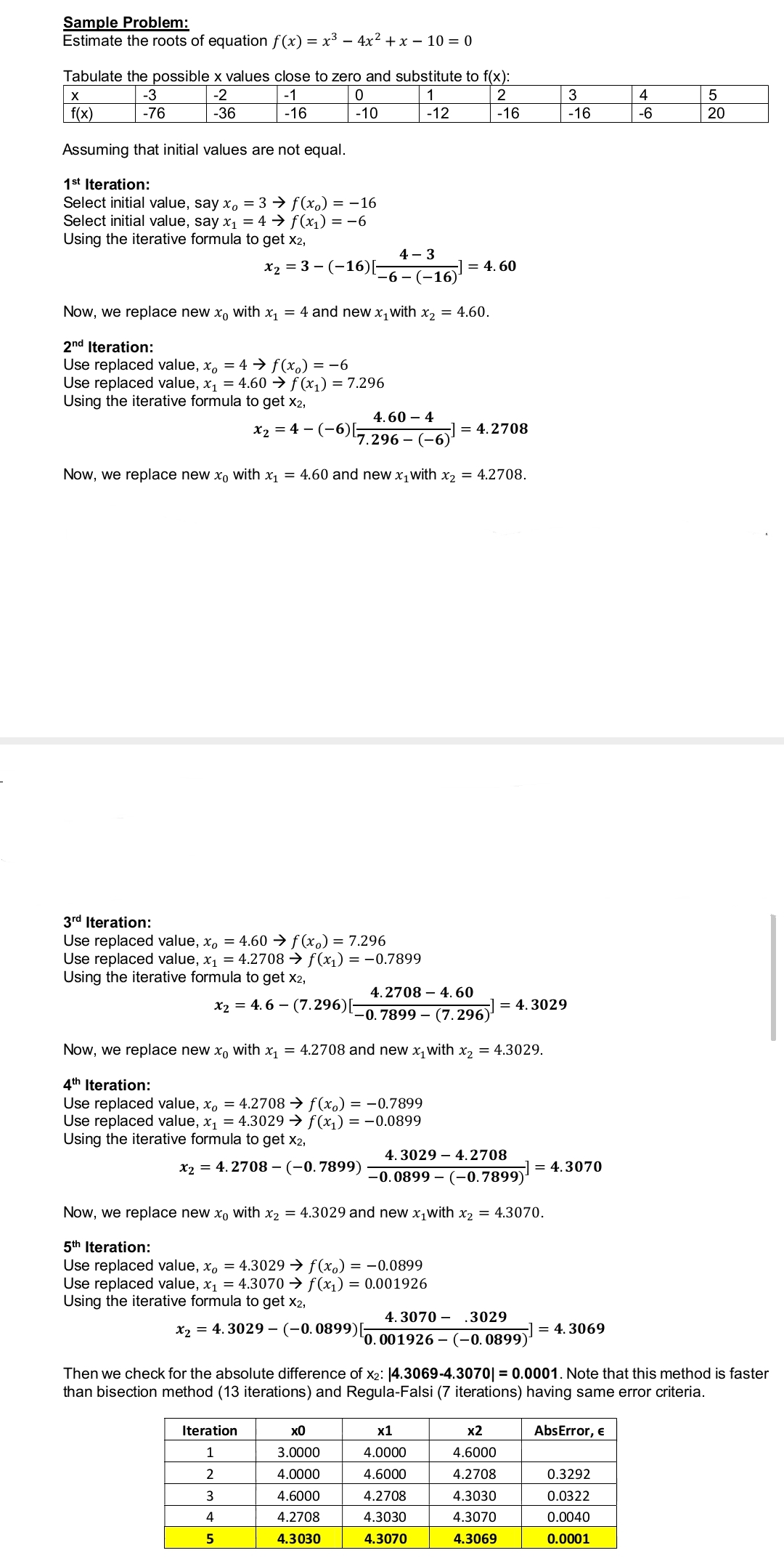Solve the following equations and compare the roots using the five methods. Tabulate the data following 5 decimal values and stop at € ≤ 0.0001 1. f(x)= x³ + 3x² - 2x - 7 The Picture below is the example of solving the problem
Solve the following equations and compare the roots using the five methods. Tabulate the data following 5 decimal values and stop at € ≤ 0.0001 1. f(x)= x³ + 3x² - 2x - 7 The Picture below is the example of solving the problem
Algebra & Trigonometry with Analytic Geometry
13th Edition
ISBN:9781133382119
Author:Swokowski
Publisher:Swokowski
Chapter5: Inverse, Exponential, And Logarithmic Functions
Section5.6: Exponential And Logarithmic Equations
Problem 64E
Related questions
Question
Solve the following equations and compare the roots using the five methods. Tabulate the data following
5 decimal values and stop at € ≤ 0.0001
1. f(x)= x³ + 3x² - 2x - 7
The Picture below is the example of solving the problem

Transcribed Image Text:Sample Problem:
Estimate the roots of equation f(x) = x³ − 4x² + x - 10 = 0
Tabulate the possible x values close to zero and substitute to f(x):
X
-3
-2
-1
0
1
2
f(x)
-76
-36
-16
-10
-12
-16
Assuming that initial values are not equal.
1st Iteration:
Select initial value, say xo = 3 → f(x) = -16
Select initial value, say x₁ = 4 ⇒ f(x₁) = −6
Using the iterative formula to get x2,
4-3
x₂ = 3 − (−16) [−6 − (−16) -= 4.60
Now, we replace new xo with x₁ = 4 and new x₁ with x₂ = 4.60.
2nd Iteration:
Use replaced value, x, = 4 ⇒ f(x) = -6
Use replaced value, x₁ = 4.60 ➜ f(x₁) = 7.296
Using the iterative formula to get x2,
x₂ =4-1
- (-6)[
4.60 4
¹7.296-(-6)
= 4.2708
Now, we replace new xo with x₁ = 4.60 and new x₁ with x₂ = 4.2708.
3rd Iteration:
Use replaced value, xo = 4.60 ➜ f(x) = 7.296
Use replaced value, x₁ = 4.2708 → f(x₁) = −0.7899
Using the iterative formula to get x2,
x₂ = 4.6 (7.296)[
4.27084.60
-0.7899 (7.296)
= 4.3029
Now, we replace new xo with x₁ = 4.2708 and new x₁ with x₂ = 4.3029.
4th Iteration:
Use replaced value, xo = 4.2708 ⇒ f(x) = -0.7899
Use replaced value, x₁ = 4.3029 → f(x₁) = -0.0899
Using the iterative formula to get X2,
x₂ = 4.2708- (-0.7899)
4.30294.2708
-0.0899- (-0.7899)
Now, we replace new xo with x₂ = 4.3029 and new x₁with x₂ = 4.3070.
5th Iteration:
Use replaced value, xo = 4.3029 → f(x) = -0.0899
Use replaced value, x₁ = 4.3070 ➜ f(x₁) = 0.001926
Using the iterative formula to get X2,
x₂ = 4.3029-(-0.0899) [
4.3070 .3029
¹0.001926 - (-0.0899)-
= 4.3069
Then we check for the absolute difference of x2: 14.3069-4.3070|= 0.0001. Note that this method is faster
than bisection method (13 iterations) and Regula-Falsi (7 iterations) having same error criteria.
x0
x1
x2
AbsError, €
Iteration
1
3.0000
4.0000
4.6000
2
4.0000
4.6000
4.2708
0.3292
3
4.6000
4.2708
4.3030
0.0322
4
4.2708
4.3030
4.3070
0.0040
5
4.3030
4.3070
4.3069
0.0001
3
-16
= 4.3070
4
-6
5
20
Expert Solution
This question has been solved!
Explore an expertly crafted, step-by-step solution for a thorough understanding of key concepts.
Step by step
Solved in 3 steps with 1 images

Recommended textbooks for you

Algebra & Trigonometry with Analytic Geometry
Algebra
ISBN:
9781133382119
Author:
Swokowski
Publisher:
Cengage

Linear Algebra: A Modern Introduction
Algebra
ISBN:
9781285463247
Author:
David Poole
Publisher:
Cengage Learning

Algebra & Trigonometry with Analytic Geometry
Algebra
ISBN:
9781133382119
Author:
Swokowski
Publisher:
Cengage

Linear Algebra: A Modern Introduction
Algebra
ISBN:
9781285463247
Author:
David Poole
Publisher:
Cengage Learning